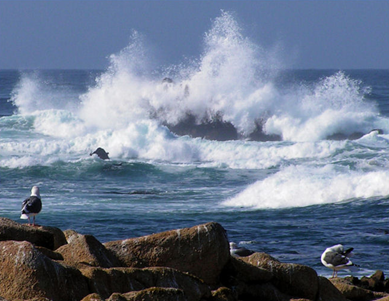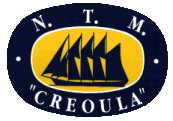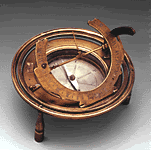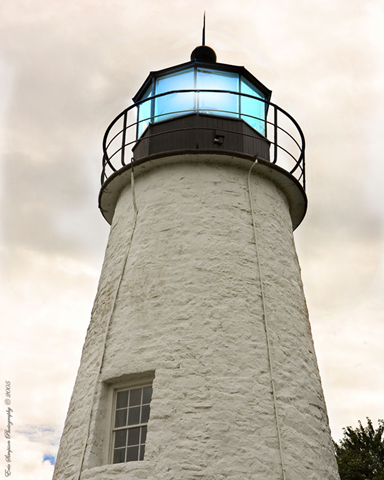
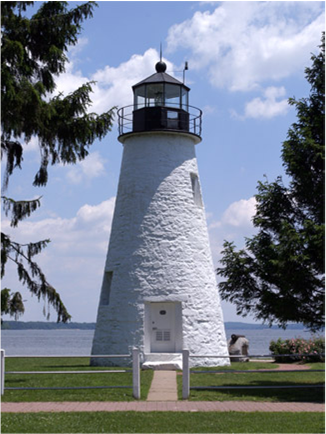
Concord Point Lighthouse at Havre de Grace, Maryland was established to warn seafaring vessels away from the treacherous currents and shoals near the mouth of the Susquehanna River. Master builder John Donahoo was responsible for the construction of the lighthouse in his hometown, where he also served multiple terms as a Havre de Grace town commissioner.
At the time of its decommissioning in 1975, the Concord Point Lighthouse had the distinction of being the oldest beacon in continuous use in the entire state of Maryland. The name Concord Point is derived from Conquered Point, which is itself a rearrangement of the original christening, Point of Conquest.
The 484-square-foot lighthouse tract was deeded to the federal government by the town commissioners in 1826, and one year later Congress approved funds for the lighthouse. A truncated conical tower topped by a nine-sided lantern and deck, the lighthouse was built with Port Deposit granite. The walls are three feet, eleven inches thick at the base of the structure, where the inside diameter of the tower is eleven feet.
A tongue and groove mahogany door, identical to the one found at Pooles Island light, guards the entranceway, while a spiral staircase made of triangular granite steps leads to a quarter-circular stone landing, from which the lantern may be accessed by climbing a slightly angled iron ship’s ladder. The lantern floor is composed of radially cut stone pieces, which are held in place by flat iron keys. The storm panels on the lantern are secured by iron mullions cast in an unusual fin shape. The original illuminating apparatus consisted of nine constant-level lamps, each with its own 16-inch reflector.
A keeper’s house, located near the lighthouse, was also built by Donahoo out of Port Deposit granite. The house, which still stands, is 34 by 20 feet and was originally built with a fireplace and a closet in each of its rooms. The building contract specified large double hung windows of eight over eight panes of glass and a shingled roof.
The kitchen, which is no longer standing, possessed “a sizable oven with an iron door, iron crane...and on one side of the chimney a sink, with a spout leading through the wall.” From the house, the keeper was able to take in the panorama of the lighthouse tower overlooking the confluence of the Susquehanna River and the Chesapeake Bay.
Over the years, the keepers at Concord Point have usually been descendants of John O’Neill, an Irish immigrant who arrived in America at age eighteen. O’Neill achieved lasting fame during the War of 1812, when British ships commanded by Admiral Sir George Cockburn turned their guns on Havre de Grace.
As a local militia lieutenant in charge of some four dozen men, O’Niell’s mission was to hold a small parapet of three cannons named Potato Battery. Many of O’Neill’s soldiers were too old to serve in the regular United States Army, and when the British opened fire they all decided to abandon their posts.
O’Neill declined to join his retreating men, and heroically took charge of one of the cannons himself. Later he described the experience: “The grape shot flew thick about me. I loaded the gun myself without anyone to serve the vent, which, you know is very dangerous, and when I fired her, she recoiled and ran over my thigh.” Shortly thereafter O’Neill was forced to retreat into town; nevertheless he procured a musket and continued to fire on the ships, all the while trying to entice the fleeing members of his troop to return and assist him.
O’Neill was eventually captured by the British and sentenced to be hanged aboard one of their ships, but his 15 year-old daughter rowed out in a skiff and plead for her father’s life. Admiral Cockburn was so impressed by her courage that he released O’Neill and gave the Irishman’s daughter a gold and tortoise-shell snuff box, which is presently in the keeping of the Maryland Historical Society.
O’Neill managed to parlay his heroic stature into a town commissioner’s position in Havre de Grace. He also managed another political appointment: first lighthouse keeper at Concord Point. At the time, the appointment of keepers was a very politicized process, with the coveted jobs usually going to those well connected to powerful decision makers.
O’Neill stayed on the job from 1927 until his death in 1838, at which time his son took over. Before the light’s automation in 1920, numerous grandsons and great-grandsons of O’Neill had served as keepers of the light.
A perusal of the Lighthouse Board’s annual reports reveals that Concord Point has been a relatively low-maintenance structure over the years. In 1855 the lantern’s nine constant-level lamps were replaced with a steamer’s lens. This in turn was upgraded to a sixth-order Fresnel lens in 1869, and then a fifth-order lens in 1891.
In 1884, an extra story was added to the keeper’s house. The light station was switched over to electrical operation in 1920, and at that time a portion of the lighthouse grounds and the keeper’s house were sold for $4,000. While the house was converted to an inn, the land around the lighthouse itself was neglected and became overgrown. The Concord Point beacon was no longer needed by 1975, and was therefore decommissioned. Mysteriously, the Fresnel lens disappeared from the tower shortly thereafter, prompting a group of concerned citizens to form the non-profit Friends of Concord Point Lighthouse to restore and maintain the structure.
The Friends helped turn the lighthouse grounds into a beautiful tree-lined park, which attracts thousands of visitors each year. The landscaping improvements made to the property are impressive, given that the grounds were in the past open and grassy, without many sizable trees. Havre de Grace town records indicate that portions of the grounds behind the keeper’s dwelling were initially swampy, requiring John O’Neill to fill them in using a horse and cart.
Recently the non-profit group has turned its attentions to the keeper’s house, which they purchased with the intention of restoring it. The dwelling has been altered significantly over the last two centuries. For its conversion to an inn, it was partitioned into numerous rooms and covered in stucco. The Friends commissioned a study of the house’s history and original architecture, which was a vital step, given the Maryland Historic Trust’s very strict standards for restorations. A before and after photograph of the dwelling show the remarkable job the Friends have done. Visitors to the lighthouse and dwelling are now afforded a glimpse into the everyday lives of lighthouse keepers and their families, circa the early 1900s.
The house stands roughly 200 feet from the tower, and Concord Street has been extended so that it now separates the two structures. Currently Concord Point Lighthouse is listed as a private aid to navigation, exhibiting a light via a fifth-order Fresnel lens. Some insist that the present lens, on loan from the Coast Guard and the Chesapeake Bay Maritime Museum, is in fact the original one that disappeared in 1975.
Located on the western side of the mouth of the Susquehanna River in Havre De Grace.Latitude: 39.5407Longitude: -76.08476



